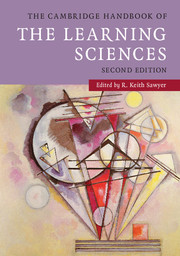Crossref Citations
This Book has been
cited by the following publications. This list is generated based on data provided by Crossref.
2006.
TEACHING.
Teachers College Record,
Vol. 108,
Issue. 1,
p.
169.
Baker, Michael J.
2015.
Learning in Work, Work in Learning.
p.
1.
Hmelo‐Silver, Cindy E.
Liu, Lei
Gray, Steven
and
Jordan, Rebecca
2015.
Using representational tools to learn about complex systems: A tale of two classrooms.
Journal of Research in Science Teaching,
Vol. 52,
Issue. 1,
p.
6.
Azevedo, Roger
2015.
Defining and Measuring Engagement and Learning in Science: Conceptual, Theoretical, Methodological, and Analytical Issues.
Educational Psychologist,
Vol. 50,
Issue. 1,
p.
84.
Masukawa, Hiroyuki
2016.
Theory and Practice of the Constructive Jigsaw Method in Advancing Domain Knowledge and Skills in Parallel.
YAKUGAKU ZASSHI,
Vol. 136,
Issue. 3,
p.
369.
Evans, Michael A.
Packer, Martin J.
and
Sawyer, R. Keith
2016.
Reflections on the Learning Sciences.
p.
1.
Packer, Martin J.
and
Maddox, Cody
2016.
Reflections on the Learning Sciences.
p.
126.
Ellis, R. A.
and
Goodyear, P.
2016.
Models of learning space: integrating research on space, place and learning in higher education.
Review of Education,
Vol. 4,
Issue. 2,
p.
149.
Stein, Mary Kay
Crowley, Kevin
and
Resnick, Lauren
2016.
Reflections on the Learning Sciences.
p.
210.
Reimann, Peter
2016.
Connecting learning analytics with learning research: the role of design-based research.
Learning: Research and Practice,
Vol. 2,
Issue. 2,
p.
130.
Jeong, Heisawn
and
Hmelo-Silver, Cindy E.
2016.
Seven Affordances of Computer-Supported Collaborative Learning: How to Support Collaborative Learning? How Can Technologies Help?.
Educational Psychologist,
Vol. 51,
Issue. 2,
p.
247.
Sawyer, R. Keith
2016.
Reflections on the Learning Sciences.
p.
259.
Geertsema, Johan
2016.
Academic development, SoTL and educational research.
International Journal for Academic Development,
Vol. 21,
Issue. 2,
p.
122.
Fuertes, Walter
Pilaluisa, Freddy
Zambrano, Margarita
Villacis, Cesar
Aules, Hernan
and
Toulkeridis, Theofilos
2017.
Intelligent agents, voice and facial recognition applied in videogames in order to stimulate cognitive development of children — A case study of Tictactoe in 3D.
p.
1152.
Pellegrino, James W.
2017.
The two disciplines problem – ‘it’s like Déjà vu all over again!’.
Assessment in Education: Principles, Policy & Practice,
Vol. 24,
Issue. 3,
p.
359.
Khuankrue, Issarapong
Kumeno, Fumihiro
Ohashi, Yutaro
and
Tsujimura, Yasuhiro
2017.
Applying Fuzzy Rule-Based System on FMEA to Assess the Risks on Project-Based Software Engineering Education.
Journal of Software Engineering and Applications,
Vol. 10,
Issue. 07,
p.
591.
Häkkinen, Päivi
Järvelä, Sanna
Mäkitalo-Siegl, Kati
Ahonen, Arto
Näykki, Piia
and
Valtonen, Teemu
2017.
Preparing teacher-students for twenty-first-century learning practices (PREP 21): a framework for enhancing collaborative problem-solving and strategic learning skills.
Teachers and Teaching,
Vol. 23,
Issue. 1,
p.
25.
Gulliksen, Marte S.
and
Hong, Andy
2017.
Making matters? Unpacking the role of practical aesthetic making activities in the general education through the theoretical lens of embodied learning.
Cogent Education,
Vol. 4,
Issue. 1,
p.
1415108.
Sickel, Aaron J.
and
Witzig, Stephen B.
2017.
Designing and Teaching the Secondary Science Methods Course.
p.
225.
Bevan, Bronwyn
2017.
Research and Practice: One Way, Two Way, No Way, or New Way?.
Curator: The Museum Journal,
Vol. 60,
Issue. 2,
p.
133.



